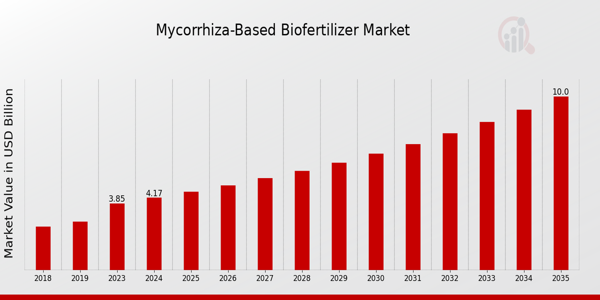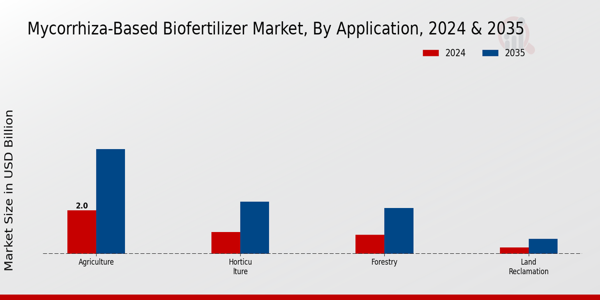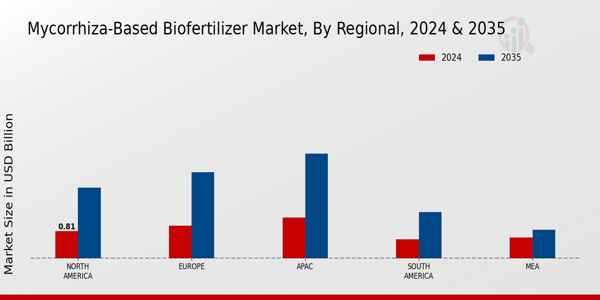Mycorrhiza-based Biofertilizer Market Overview
Mycorrhiza-based Biofertilizer Market Size was estimated at 3.85 (USD Billion) in 2023. The Mycorrhiza-based Biofertilizer Industry is expected to grow from 4.17 (USD Billion) in 2024 to 10.0 (USD Billion) by 2035. The Mycorrhiza-based Biofertilizer Market CAGR (growth rate) is expected to be around 8.28% during the forecast period (2025 - 2035).

Source: Primary Research, Secondary Research, MRFR Database and Analyst Review
Key Mycorrhiza-based Biofertilizer Market Trends Highlighted
The growing need for sustainable agriculture solutions and growing awareness of organic farming techniques are driving the significant rise of the global Mycorrhiza-based biofertilizer market.
Mycorrhizal fungi are becoming a more popular option for farmers and agricultural enterprises looking to improve soil health and increase crop yields. The desire to address environmental issues related to conventional farming and lessen reliance on chemical fertilizers are factors driving this change.
The potential of Mycorrhiza-based biofertilizers to boost plant nutrient uptake, boost stress tolerance, and improve soil structure is becoming more widely acknowledged, which makes them a desirable choice for contemporary agriculture.
There are a lot of opportunities in this sector, especially with the growing emphasis on sustainable and environmentally friendly farming practices. A favorable environment for the growth of Mycorrhiza-based goods is created by the global proliferation of organic farming methods.
Furthermore, producers are able to accommodate a variety of crops and soil types thanks to increased innovation in biofertilizer formulas brought about by developments in agricultural technology and research.
Mycorrhiza-basedMycorrhiza-basedMycorrhiza-based
Collaborations between agricultural stakeholders and increased funding for research are further enhancing the market landscape. Recent trends show a shift towards incorporating microbial solutions in crop management strategies.
More farmers are recognizing the benefits of integrating mycorrhiza into their cultivation practices, which promotes soil biodiversity and promotes long-term ecological balance. Educational initiatives aimed at informing farmers about the benefits of mycorrhizae are becoming prevalent, further encouraging the adoption of these biofertilizers.
As consumer preferences lean toward organic and sustainably produced food, the demand for effective solutions like Mycorrhiza-based biofertilizers will likely continue to grow, shaping the future of agricultural practices around the world.
Mycorrhiza-based Biofertilizer Market Drivers
Growing Awareness of Sustainable Agriculture
The inclination towards sustainable agricultural practices is a major driver of growth in the Global Mycorrhiza-based Biofertilizer Market. As the global population continues to rise, the demand for increased food production presents significant challenges.
Chemical fertilizers, while effective, come with environmental risks and health concerns. Consequently, farmers and stakeholders in agriculture are more inclined to adopt eco-friendly alternatives, such as Mycorrhiza-based biofertilizers, which naturally enhance soil fertility and crop yields.
This shift is not just a trend but a necessary transformation in agriculture aimed at preserving the ecosystem while maintaining productivity. The growing awareness about the adverse impacts of conventional fertilizers leads consumers and agricultural sectors to seek organic and sustainable options.
Furthermore, a number of governmental organizations and NGOs are promoting sustainable farming practices, emphasizing the use of biofertilizers. These organizations provide support and education related to sustainable methods, thereby catalyzing the uptake of Mycorrhiza-based biofertilizers.
Farmers are increasingly recognizing that adopting these practices not only resolves the issues related to soil quality depletion and chemical runoff but also improves their long-term operational viability. As the market for sustainable products expands, a collective push towards utilizing bio inputs like Mycorrhiza-based fertilizers can be expected, further solidifying their role in the future of food production.
Rising Demand for Organic Produce
The rising demand for organic produce is significantly influencing the Global Mycorrhiza-based Biofertilizer Market. As consumers become more health conscious and aware of the benefits of organic foods, the agricultural sector strives to meet these growing demands. Mycorrhiza-based biofertilizers offer an effective solution that aligns with organic farming practices. By enhancing nutrient absorption and soil health, these biofertilizers support the production of high-quality organic crops.
This shift towards organic farming is expected to drive substantial growth in the market, fostering opportunities for sustainable and eco-friendly agricultural inputs.
Government Support and Regulations
Government policies aimed at promoting environmental sustainability actively contribute to the growth of the Global Mycorrhiza-based Biofertilizer Market. Many countries are implementing regulations that encourage organic farming and the use of biofertilizers, offering financial incentives for farmers willing to transition from chemical-based inputs to bio-based alternatives.
Such support not only aids farmers in adopting innovative practices but also helps in the reduction of environmental degradation caused by traditional fertilizers.
This favorable regulatory landscape fosters a conducive environment for the Mycorrhiza-based biofertilizer market, paving the way for long-term growth.
Mycorrhiza-based Biofertilizer Market Segment Insights:
Mycorrhiza-based Biofertilizer Market Application Insights
The Global Mycorrhiza-based Biofertilizer Market demonstrated robust growth potential across various application sectors, particularly within Agriculture, Horticulture, Forestry, and Land Reclamation. Among the application areas, Agriculture held the majority share, with a valuation of 2.0 USD Billion in 2024, reflecting its critical role in food production and sustainable farming practices.
The Agriculture sector is expected to see significant advancements due to increasing emphasis on organic farming and eco-friendly agricultural techniques, driving its growth further.
Horticulture also contributed meaningfully to the market, valued at 1.0 USD Billion in 2024, as rising interest in gardening and ornamental plants boosts the demand for biofertilizers that support healthy plant development.
The Forestry application was valued at 0.87 USD Billion in 2024. This segment gained importance from reforestation efforts and sustainable forest management practices, aiming to restore ecosystems and enhance biodiversity.
Furthermore, Land Reclamation, valued at 0.3 USD Billion in 2024, was vital in restoring degraded land, which supports the growth of native vegetation and improves soil quality. Collectively, these sectors exhibited a keen interest in Mycorrhiza-based biofertilizers, responding to global demands for sustainable agricultural practices while addressing environmental challenges.
The trends underscored a shift towards ecological solutions in agriculture and related fields, which are expected to thrive as awareness of sustainable practices increases, ultimately influencing the trajectory of the Global Mycorrhiza-based Biofertilizer Market revenue over the forecast period.

Source: Primary Research, Secondary Research, MRFR Database and Analyst Review
Mycorrhiza-based Biofertilizer Market Product Type Insights
The market is characterized by a diverse Product Type categorization that includes Powder, Granules, and Liquid formats. Each of these variants plays a critical role in the market due to their specific applications and advantages in enhancing soil health and crop yield. Powder formulations are popular for their ease of application and effectiveness in root colonization, while Granules offer a controlled release, promoting long-term nutrient availability.
Liquid products provide flexibility in application methods, making them suitable for various farming practices. As awareness of the benefits of mycorrhizal fungi continues to rise, the segment is supported by a growing trend toward organic farming and environmentally friendly input options.
While all product types cater to different consumer preferences and agricultural needs, Powder and Granules dominate market share due to their widespread utilization in both large-scale farming and home gardening. Overall, the Global Mycorrhiza-based Biofertilizer Market data reflects an evolving industry poised for significant growth, driven by consumer demand for organic and sustainable agricultural solutions.
Mycorrhiza-based Biofertilizer Market Formulation Insights
The Global Mycorrhiza-based Biofertilizer Market, particularly in the Formulation segment, is set to witness significant growth. This segment plays a crucial role in enhancing agricultural productivity through improved soil health and nutrient availability.
Within the Formulation segment, both single-strain and Multi-Strain formulations are important. Single-strain formulations are often favored for their specific applications and targeted efficacy, while multi-strain formulations are gaining traction due to their ability to provide a broader spectrum of benefits, catering to diverse crop needs and soil characteristics.
The rising demand for sustainable farming practices and organic fertilizers drives the growth of this market segment, reflecting an alignment with current trends toward environmental responsibility. However, there are challenges, such as awareness and education regarding the benefits of Mycorrhiza-based solutions among farmers.
The opportunities in this market are vast, with increasing interest in precision agriculture and biotechnological advancements paving the way for innovative product developments. The Global Mycorrhiza-based Biofertilizer Market data illustrates that this sector is evolving, driven by changing consumer preferences and regulatory support for organic farming initiatives.
Mycorrhiza-based Biofertilizer Market End Use Insights
The growth is significantly influenced by the End Use categories, primarily Organic Farming and Conventional Farming. Organic Farming holds a substantial position, driven by increasing consumer demand for chemical-free produce and sustainable agricultural practices. As organic practices gain traction, they foster greater reliance on biofertilizers, enhancing soil health and crop yields.
On the other hand, Conventional Farming utilizes these biofertilizers to improve nutrient absorption efficiency and reduce chemical fertilizer usage, paving a pathway for more environmentally friendly farming practices.
The Global Mycorrhiza-based Biofertilizer Market revenue reflects strong support from both segments, emphasizing their important roles in addressing the ongoing challenges of agricultural sustainability and meeting the food production needs of a growing global population. Market growth is further fueled by technological advancements and increasing awareness about the health benefits of biofertilizers.
Overall, the Global Mycorrhiza-based Biofertilizer Market data highlights a dynamic interplay between these End Use areas, foreseeing continued investment and development in the coming years.
Mycorrhiza-based Biofertilizer Market Regional Insights
The Global Mycorrhiza-based Biofertilizer Market experienced noteworthy growth across various regions, contributing significantly to the overall market landscape. In 2024, North America achieved a valuation of 0.807 USD Billion, growing to 2.104 USD Billion by 2035. Europe followed closely, valued at 0.968 USD Billion in 2024 and expected to reach 2.562 USD Billion by 2035, indicating its strong presence in the market.
The APAC region dominated the market with a more substantial value of 1.21 USD Billion in 2024, appearing to be a pivotal driver for growth, potentially due to its large agricultural sector and increasing adoption of sustainable practices.
South America held a value of 0.565 USD Billion in 2024, showcasing a significant interest in biofertilizers as the region enhances its agricultural efficiency, while the MEA region was valued at 0.621 USD Billion in 2024, representing a growing awareness of biofertilizer benefits amidst challenging agricultural conditions.
These valuations reflected the variations in market dynamics, with APAC leading in revenue, driving the overall growth within the Global Mycorrhiza-based Biofertilizer Market, creating ample opportunities for innovation and expansion.
Moreover, trends toward sustainable agriculture and organic farming are influencing market preferences and growth opportunities across these regions.

Source: Primary Research, Secondary Research, MRFR Database and Analyst Review
Mycorrhiza-based Biofertilizer Market Key Players and Competitive Insights:
The Global Mycorrhiza-based Biofertilizer Market has rapidly evolved, reflecting increasing demand for sustainable agricultural practices. The competitive landscape is characterized by a blend of established players and emerging entities that are committed to developing innovative solutions to enhance soil health and crop productivity. Companies in this market are focusing on R&D to create efficient biofertilizer products that capitalize on the benefits of mycorrhizal fungi.
The necessity for eco-friendly farming technologies is driving the competitive dynamics, influencing pricing strategies, distribution channels, and marketing techniques. Furthermore, the market is influenced by regulatory frameworks and environmental awareness among farmers, prompting companies to adapt and respond to these changing conditions effectively.
In the competitive scenario, Green Center stands out due to its extensive market presence and robust product portfolio. The company has allocated significant resources towards the research and development of high-quality Mycorrhiza-based biofertilizers, ensuring that its offerings meet the specific needs of diverse crop types and soil conditions.
Green Center's strengths lie in its established brand reputation and commitment to sustainability, which resonates with environmentally conscious consumers. The organization has also fostered strong relationships with agricultural institutions and universities, enhancing its credibility in the field of biofertilizers.
With strategically located facilities and a comprehensive distribution network, Green Center is well-positioned to meet the growing global demand for Mycorrhiza-based products, leveraging its strengths to achieve competitive advantage.
On the other hand, MycoGold has emerged as a key player in the Global Mycorrhiza-based Biofertilizer Market, recognized for its innovative approach to biological solutions in agriculture. The company focuses on providing tailored mycorrhizal products that improve nutrient uptake and water efficiency for various crop species. MycoGold has established a reputation for its high-quality formulations that support plant health and growth, thereby appealing to a broad customer base.
The company emphasizes customer education and outreach, helping farmers understand the benefits and application of Mycorrhiza-based fertilizers. With a commitment to sustainable practices and ongoing expansion into new markets, MycoGold continues to innovate while maintaining a focus on sustainability, making it a formidable competitor in the biofertilizer industry.
Key Companies in the Mycorrhiza-based Biofertilizer Market Include:
- Green Center
- MycoGold
- Bayer AG
- AminoAg
- Novozymes
- Koppert Biological Systems
- Syngenta
- EcoTechnologies
- BioWorks
- Plant Health Care
- Earthfort
- Trifecta Ecosystems
- Sustenir Agriculture
- Agrinos
- FMC Corporation
Mycorrhiza-based Biofertilizer Market Developments
The Global Mycorrhiza-based Biofertilizer Market is witnessing notable developments as companies focus on innovative products and strategic collaborations. Green Center recently expanded its product line to include new mycorrhizal formulations aimed at enhancing soil health. MycoGold has reported increased demand for its biofertilizers, attributed to the rising awareness of sustainable farming practices.
Bayer AG continues to invest in research and development to strengthen its position in this sector. AminoAg and Novozymes are collaborating on research to incorporate microbial solutions in their biofertilizers, showcasing a trend of synergistic partnerships aimed at boosting efficacy.
Meanwhile, Koppert Biological Systems and Syngenta are actively pursuing sustainable agriculture initiatives, emphasizing the importance of biofertilizers in improving crop yields. EcoTechnologies and BioWorks are also expanding their market presence through innovative products that leverage mycorrhizal technology.
Notably, some companies are exploring potential mergers or acquisitions to enhance their market reach and product offerings, indicating a dynamic landscape that is responding to growing environmental concerns. The overall valuation of companies in the sector is increasing, driven by heightened interest in organic farming and regulatory support for biofertilizers, reflecting a strong growth trajectory in the market.
Mycorrhiza-based Biofertilizer Market Segmentation Insights
Mycorrhiza-based Biofertilizer Market Application Outlook
- Agriculture
- Horticulture
- Forestry
- Land Reclamation
Mycorrhiza-based Biofertilizer Market Product Type Outlook
Mycorrhiza-based Biofertilizer Market Formulation Outlook
- Single Strain
- Multi Strain
Mycorrhiza-based Biofertilizer Market End Use Outlook
- Organic Farming
- Conventional Farming
Mycorrhiza-based Biofertilizer Market Regional Outlook
- North America
- Europe
- South America
- Asia Pacific
- Middle East and Africa
|
Report Attribute/Metric
|
Details
|
|
Market Size 2023
|
3.85(USD Billion)
|
|
Market Size 2024
|
4.17(USD Billion)
|
|
Market Size 2035
|
10.0(USD Billion)
|
|
Compound Annual Growth Rate (CAGR)
|
8.28% (2025 - 2035)
|
|
Report Coverage
|
Revenue Forecast, Competitive Landscape, Growth Factors, and Trends
|
|
Base Year
|
2024
|
|
Market Forecast Period
|
2025 - 2035
|
|
Historical Data
|
2019 - 2024
|
|
Market Forecast Units
|
USD Billion
|
|
Key Companies Profiled
|
Green Center, MycoGold, Bayer AG, AminoAg, Novozymes, Koppert Biological Systems, Syngenta, EcoTechnologies, BioWorks, Plant Health Care, Earthfort, Trifecta Ecosystems, Sustenir Agriculture, Agrinos, FMC Corporation
|
|
Segments Covered
|
Application, Product Type, Formulation, End Use, Regional
|
|
Key Market Opportunities
|
Rising organic farming trends, Increased awareness of sustainability, Government support for biofertilizers, Growing global food demand, Expansion into emerging markets
|
|
Key Market Dynamics
|
Rising organic farming adoption, Increasing environmental concerns, Need for sustainable agriculture, Growing demand for bio-based products, Government regulations supporting biofertilizers
|
|
Countries Covered
|
North America, Europe, APAC, South America, MEA
|
Frequently Asked Questions (FAQ) :
The Global Mycorrhiza-Based Biofertilizer Market is expected to be valued at 4.17 billion USD in 2024.
By 2035, the market value is projected to reach 10.0 billion USD.
The expected CAGR for the market from 2025 to 2035 is 8.28%.
In 2024, the Agriculture segment is expected to have the highest market value at 2.0 billion USD.
The market size for the Horticulture application is valued at 1.0 billion USD in 2024.
The North American region is projected to reach 2.104 billion USD by 2035.
The APAC region is expected to experience significant growth, rising from 1.21 billion USD in 2024 to 3.111 billion USD by 2035.
Key players include Green Center, MycoGold, Bayer AG, AminoAg, and Novozymes, among others.
The Forestry application market size is expected to grow to 2.1 billion USD by 2035.
The Land Reclamation application is projected to be valued at 0.7 billion USD by 2035.

















